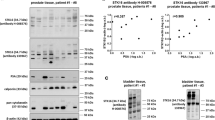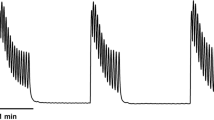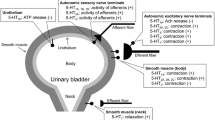Abstract
Propiverine is a commonly used antimuscarinic drug used as therapy for symptoms of an overactive bladder. Propiverine is extensively biotransformed into several metabolites that could contribute to its spasmolytic action. In fact, three propiverine metabolites (M-5, M-6 and M-14) have been shown to affect various detrusor functions, including contractile responses and L-type calcium-currents, in humans, pigs and mice, albeit with different potency. The aim of our study was to provide experimental evidence for the relationship between the binding of propiverine and its metabolites to human muscarinic receptor subtypes (hM1–hM5) expressed in chinese hamster ovary cells, and to examine the effects of these compounds on muscarinic receptor-mediated detrusor function. Propiverine, M-5, M-6 and M-14 bound to hM1–hM5 receptors with the same order of affinity for all five subtypes: M-6 > propiverine > M-14 > M-5. In HEK-293 cells expressing hM3, carbachol-induced release of intracellular Ca2+ ([Ca2+]i) was suppressed by propiverine and its metabolites; the respective concentration-response curves for carbachol-induced Ca2+-responses were shifted to the right. At higher concentrations, propiverine and M-14, but not M-5 and M-6, directly elevated [Ca2+]i. These results were confirmed for propiverine in human detrusor smooth muscle cells (hDSMC). Propiverine and the three metabolites decreased detrusor contractions evoked by electric field stimulation in a concentration-dependent manner, the order of potency being the same as the order of binding affinity. We conclude that, in comparison with the parent compound, loss of the aliphatic side chain in propiverine metabolites is associated with higher binding affinity to hM1–hM5 receptors and higher functional potency. Change from a tertiary to a secondary amine (M-14) results in lower binding affinity and reduced potency. Oxidation of the nitrogen (M-5) further lowers binding affinity as well as functional potency.








Similar content being viewed by others
References
Andersson KE, Yoshida M (2003) Antimuscarinics and the overactive detrusor – which is the main mechanism of action? Eur Urol 43:1–5
Andersson KE, Arner A (2004) Urinary bladder contraction and relaxation: physiology and pathophysiology. Physiol Rev 84:935–986
Andersson KE, Appell R, Cardozo LD, Chapple C, Drutz HP, Finkbeiner AE, Haab F, Vela Navarrete R (1999) The pharmacological treatment of urinary incontinence. BJU Int 84:923–947
Andersson KE, Appell R, Awad S, Chapple C, Drutz HP, Finkbeiner AE, Fourcroy J, Haab F, Wein A (2002) Pharmacological treatment of urinary incontinence. In: Abrams P, Cardozo L, Khoury S, Wein A (eds) Incontinence, 2nd International Consultation on Incontinence, Plybridge, UK, pp 481–511
Borchert VE, Czyborra P, Fetscher C, Goepel M, Michel MC (2004) Extracts from Rhois aromatica and Solidaginis virgaurea inhibit rat and human bladder contraction. Naunyn Schmied Arch Pharmacol 369:281–286
Chapple CR (2004) Darifenacin: a novel M3 muscarinic selective receptor antagonist for the treatment of overactive bladder. Expert Opin Investig Drugs 13:1493–500
Chess-Williams R, Chapple CR, Yamanishi T, Yasuda K, Sellers DJ (2001) The minor population of M3-receptors mediate contraction of human detrusor muscle in vitro. J Auton Pharmacol 21:243–248
Fetscher C, Fleichman M, Schmidt M, Krege S, Michel MC (2002) M3 muscarinic receptors mediate contraction of human urinary bladder. Br J Pharmacol 136:641–644
Gillespie JI, Harvey IJ, Drake MJ (2003) Agonist- and nerve-induced phasic activity in the whole isolated bladder of the guinea pig: evidence for two types of bladder activity. Exp Physiol 88:343–357
Grynkiewicz G, Poenie M, Tsein RY (1985) A new generation of Ca2+ indicators with greatly improved fluorescence properties. J Biol Chem 260:3340–3350
Guay DR (2003) Clinical pharmacokinetics of drugs used to treat urge incontinence. Clin Pharmacokinet 42:1243–1285
Harrison SC, Sibley GN, Doyle PT, Ferguson DR (1988) The use of endoscopic detrusor muscle biopsies for in vitro muscle strip studies. Br J Urol 61:210–212
Haruno A (1992) Inhibitory effects of propiverine hydrochloride on the agonist-induced or spontaneous contractions of various isolated muscle preparations. Arzneim-Forsch/Drug Res 42:815–817
Haustein KO, Hüller G (1988) On the pharmacokinetics and metabolism of propiverine in man. Eur J Drug Metab Pharmacokinet 13:81–90
Hawthorn MH, Chapple CR, Cock M, Chess-Williams R (2000) Urothelium-derived inhibitory factor(s) influences on detrusor muscle contractility in vitro. Br J Pharmacol 129:416–419
Hedge S (2006) Muscarinic receptors in the bladder: from basic research to therapeutics. Br J Pharmacol 147:S80–S87
Ikeda K, Kobayashi S, Suzuki M, Miyata K, Takeuchi M, Yamada T, Honda K (2002) M(3) receptor antagonism by the novel antimuscarinic agent solifenacin in the urinary bladder and salivary gland. Naunyn Schmied Arch Pharmacol 366:97–103
Madersbacher H, Mürtz G (2001) Efficacy, tolerability and safety profile of propiverine in the treatment of the overactive bladder (non-neurogenic and neurogenic). World J Urol 19:324–335
Malysz J, Buckner SA, Daza AV, Milicic I, Perez-Medrano A, Gopalakrishnan M (2004) Functional characterization of large conductance calciumactivated K+ channel openers in bladder and vascular smooth muscle. Naunyn Schmied Arch Pharmacol 369:481–489
Mansfield KJ, Liu L, Mitchelson FJ, Moore KH, Millard RJ, Burcher E (2005) Muscarinic receptor subtypes in human bladder detrusor and mucosa, studied by radioligand binding and quantitative competitive RT-PCR: changes in ageing. Br J Pharmacol 144:1089–1099
Maruyama S, Oki T, Otsuka A, Shinbo H, Ozono S, Kageyama S, Mikami Y, Araki I, Takeda M, Masuyama K, Yamada S (2006) Human muscarinic receptor binding characteristics of antimuscarinic agents to treat overactive bladder. J Urol 175:365–369
Naerger H, Fry C, Nilvebrant L (1995) Effect of tolterodine on electrically induced contractions of isolated human detrusor muscle from stable and unstable bladders [abstract]. Neurourol Urodyn 14:524–526
Nilvebrant L, Andersson KE, Gillberg PG, Stahl M, Sparf B (1997) Tolterodine - a new bladder-selective antimuscarinic agent. Eur J Pharmacol 327:195–207
Oki T, Sato S, Miyata K, Yamada S (2005) Muscarinic receptor binding, plasma concentration and inhibition of salivation after oral administration of a novel antimuscarinic agent, solifenacin succinate in mice. Br J Pharmacol 145:219–227
O’Reilly BA, Kosaka AH, Knight GF, Chang TK, Ford APDW, Rymer JM, Popert R, Burnstock G, McMahon S (2002) P2X receptors and their role in female idiopathic detrusor instability. J Urol 167:157–164
Ouslander JG (2004) Management of overactive bladder. N Engl J Med 350:786–799
Rehavi M, Weiss H, Nissenkorn I, Rubinstein R, Cohen S (1987) A comparative study of the affinities of some tricyclic antidepressants for the muscarinic cholinergic receptor in human and guinea-pig bladder, ileum and brain in relation to differential drug potency. Life Sci 40:1819–1827
Schmidt M, Bienek C, van Koppen CJ, Michel MC, Jakobs KH (1995) Diferential calcium signalling be M2 and M3 muscarinic acethylcholine receptors in a single cell type. Naunyn Schmied Arch Pharmacol 352:469–476
Schneider T, Fetscher C, Krege S, Michel MC (2004a) Signal transduction underlying carbachol-induced contraction of human urinary bladder. J Pharmacol Exp Therap 309:1148–1153
Schneider T, Hein P, Michel MC (2004b) Signal transduction underlying carbachol-induced contraction of rat urinary bladder. I. Phospholipases and Ca2+ sources. J Pharmacol Exp Therap 308:47–53
Schneider T, Hein P, Michel-Reher MB, Michel MC (2005) Effects of ageing on muscarinic receptor subtypes and function in rat urinary bladder Naunyn Schmied Arch Pharmacol 372:71–78
Sellers DJ, Chapple CR, Chess-Williams R (2001) Potential therapeutic targets for treatment of the overactive bladder. World J Urol 19:307–311
Siegmund W, Niguissie M, Talahun K, Aitenfissu H, Franke G, Wengler A (1990) Anticholinergic properties of propiverine and its metabolites. Pharmazie 45:67–68
Siepmann M, Nokhodian A, Thümmler D, Kirch W (1998) Pharmacokinetics and safety of propiverine in patients with fatty liver disease. Eur J Clin Pharmacol 54:767–771
Tokuno H, Chowdhury JU, Tomita T (1993) Inhibitory effects of propiverine on rat and guinea-pig urinary bladder muscle. Naunyn-Schmied Arch Pharmacol 348:659–662
Wada Y, Yoshida M, Kitani K, Kikukawa H, Ichinose A, Takahashi W, Gotoh S, Inadome A, Machida J, Ueda S (1995) Comparison of the effects of anticholinergic drugs on human isolated urinary bladder. Arch Int Pharmacodyn 330:76–79
Wegener JW, Schulla V, Lee TS, Koller A, Feil S, Feil R, Kleppisch T, Klugbauer N, Moosmang S, Welling A, Hofmann F (2004) An essential role of Cav1.2 L-type calcium channel for urinary bladder function. FASEB J 18:1159–1161
Wuest M, Averbeck B, Reif S, Bräter M, Ravens U (2002) Different responses to drugs against overactive bladder in detrusor muscle of pig, guinea pig and mouse. Eur J Pharmacol 454:59–69
Wuest M, Morgenstern K, Graf EM, Braeter M, Hakenberg OW, Wirth MP, Ravens U (2005a) Cholinergic and purinergic responses in isolated human detrusor in relation to age. J Urol 173:2182–2189
Wuest M, Hecht J, Christ T, Braeter M, Schoeberl C, Hakenberg OW, Wirth MP, Ravens U (2005b) Pharmacodynamics of propiverine and three of its main metabolites on detrusor contraction. Br J Pharmacol 145:608–619
Wuest M, Kaden S, Hakenberg OW, Wirth MP, Ravens U (2005c) Effect of rilmakalim on detrusor contraction in the presence and absence of urothelium. Naunyn-Schmied Arch Pharmacol 372:203–212
Yamanishi T, Chapple CR, Yasuda K, Chess-Williams R (2000) The role of M2 muscarinic receptors in mediating contraction of the pig urinary bladder in vitro. Br J Pharmacol 131:1482–1488
Yono M, Yoshida M, Wada Y, Kikukawa H, Takahashi W, Inadome A, Seshita H, Uead S (1999) Pharmacological effects of tolterodine on human isolated urinary bladder. Eur J Pharmacol 368:223–230
Acknowledgements
The authors would like to thank Sabine Kirsch for her technical assistance. This project was supported in part by a grant from the “Inno-Regio-Project” BioMet (BMBF, project number 05) from the German Bundesministerium für Bildung und Forschung.
Author information
Authors and Affiliations
Corresponding author
Rights and permissions
About this article
Cite this article
Wuest, M., Weiss, A., Waelbroeck, M. et al. Propiverine and metabolites: differences in binding to muscarinic receptors and in functional models of detrusor contraction. Naunyn-Schmied Arch Pharmacol 374, 87–97 (2006). https://doi.org/10.1007/s00210-006-0103-0
Received:
Accepted:
Published:
Issue Date:
DOI: https://doi.org/10.1007/s00210-006-0103-0




